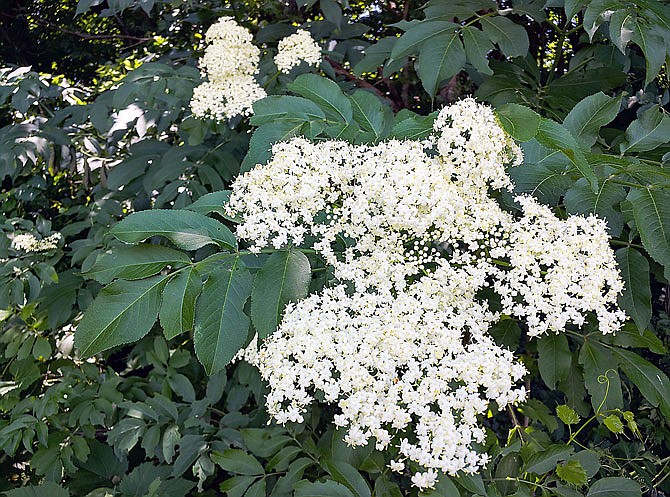Elderberries are good for you and good for wildlife, too, according to the Missouri Department of Conservation.
Jamie Koehler, the assistant manager at MDC's Cape Girardeau Nature Center, gave a virtual presentation Tuesday on the useful native shrub. It's one of her favorite wild edible plants, she said, and she's not alone in that opinion.
"It's very easy nowadays to find elderberries because they're so popular," she said.
Finding elderberries
Elderberry plants grow as large shrubs or small trees. They can reach 25 feet in height, though 8-10 feet is more common.
The plants are most easily recognized by their flowers and berries. In May through July, they grow large umbrella-shaped clusters of sweet-smelling white flowers. Between August and October, the flowers are replaced by flat-topped clusters of glossy purple or black berries.
The leaves are also fairly distinctive: They're compound leaves with opposite leaflets and serrated edges.
Elderberries are often found along the edges of woods or fence-rows.
Two species of elderberry, Sambucus canadensis and Sambucus nigra, are native to Missouri. The two species are very closely related; in fact, S. canadensis may be a subspecies of S. nigra.
If elderberries aren't on offer at your local grocery store or farmer's market, you can forage or - if your property is suitable - grow your own.
"You really need to know what you're doing before you go foraging," Koehler warned.
She suggested doing extensive research to ensure you're able to properly identify elderberry plants before using any you forage. Also, be sure to get permission from the landowner before foraging, or, if foraging on public land, make sure the rules permit doing so. Do not forage near areas where pesticides or herbicides have been sprayed.
"Another ethical foraging thing is to only take what you can use," Koehler added. "Try to be aware of our endangered species so you don't disrupt any of those habitats."
If you harvest too many elderberries, they keep well in the freezer; they can also be juiced, and the juice can be frozen or turned into jelly.
Elderberry plants can be purchased from the MDC's George O. White Nursery, though they sell out quickly.
Historic use
Elderberries are having a moment right now, Koehler said, as recent studies have highlighted their abundance of antioxidants. But the plants have long been used as food, medicine and crafting materials.
"This plant has been around, I'm guessing, since the beginning of time," she said. "It's been very, very popular throughout history."
Their hollow stems can be used as toys, turned into instruments and even hammered into maple trees to harvest sap. Its berries are eaten and turned into inks and dyes. And various parts of the plant have been used to treat a wide variety of ailments - though today it is known all parts of the plant aside from its flowers and berries contain a poisonous glycoside, and thus shouldn't be eaten.
Long ago, Europeans drew connections between elderberries and fairies.
"People thought that if you slept under an elderberry bush, afterward you'd be able to see the fairies," Koehler said.
Use today
In the present, people eat elderberries and elderflowers.
"The taste of elderberry is not phenomenal," Koehler admitted. "They're tart, and the berries are really small."
But gather enough berries and add some sugar, and they can star in jams and jellies, syrups, pies, wines and teas.
However, the berries should not be eaten raw: Aside from not tasting like much, they may cause stomach upset, Koehler said.
The fragrant elderflower is also edible. They can be used to infuse cordials or alcohols. Or, you can dip the whole flower-head into batter and fry it, dusting lightly with powdered sugar.
"It's like a funnel cake," Koehler said.
The plants also attract and host a wide variety of birds - more than 20 native species of bird enjoy elderberries, including the colorful indigo bunting and cedar waxwing. Bugs love them, too. There's even a species of beetle specialized living on the plants, the elderberry borer.
"Some people wanting the fruit say that's not what I want, they're pests," Koehler said. "Well, they are pests, but also they're food for birds. I think a leaf with a hole in it is just as beautiful as a leaf without."
Many practitioners of alternative and traditional medicine tout elderberry extract as a treatment for cold and flu, though research into its efficacy is inconclusive. Studies in the early 2000s suggested an elderberry extract could shorten the duration of cold symptoms, but a much larger study published in 2020 found no difference in the duration in flu symptoms between people taking an extract and people taking a placebo.
Regardless, growing and selling elderberries is getting to be a big business in Missouri. The University of Missouri Extension has put out a guide on how to grow and market elderberries commercially (bit.ly/3pJ2Qtf). There's even an elderberry farm in Callaway County: ElderBlossom View in New Bloomfield.
To learn more about elderberries, Koehler suggests visiting the websites of the MU Extension, River Hills Harvest (riverhillsharvest.com/growers) and the American Botanical Council (herbalgram.org). The book "Everything Elderberry" by Susannah Shmurak also has useful information and recipes.
To view and register for future MDC virtual classes, visit mdc.mo.gov/events.

